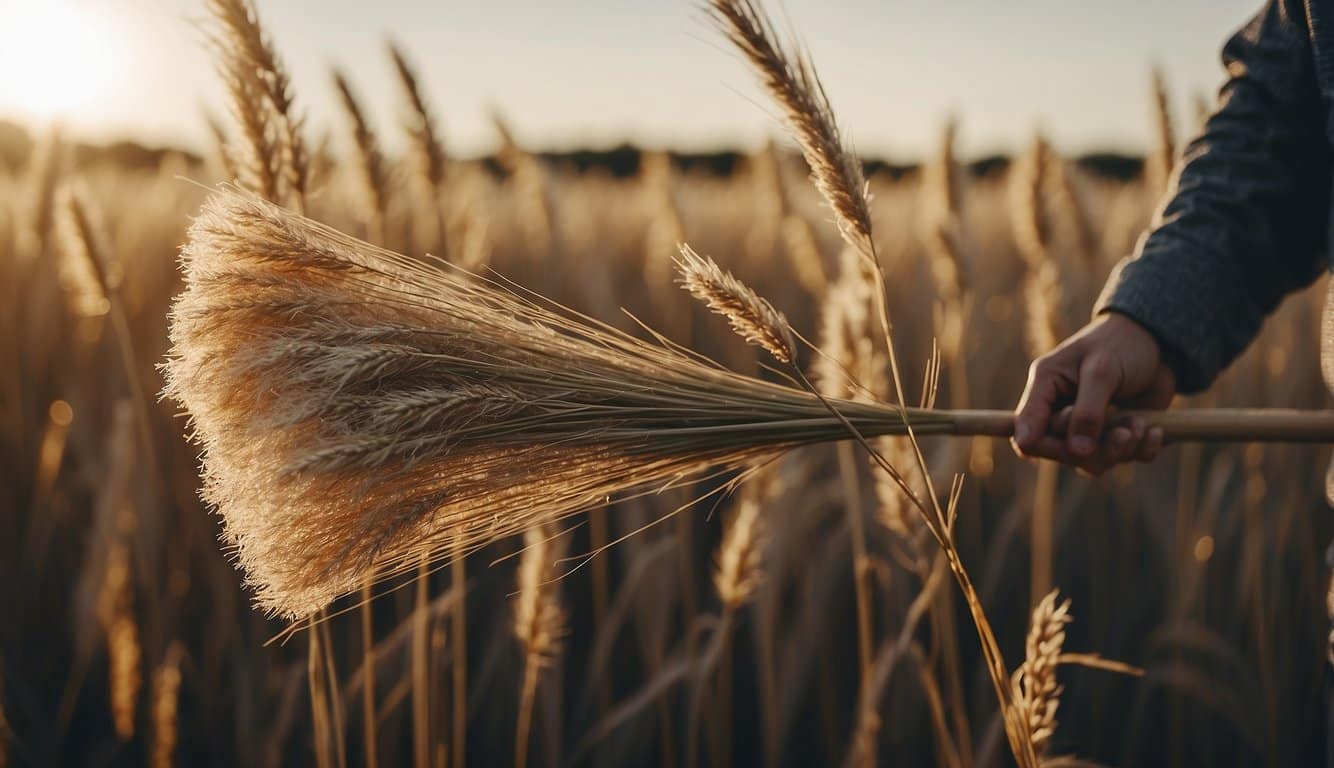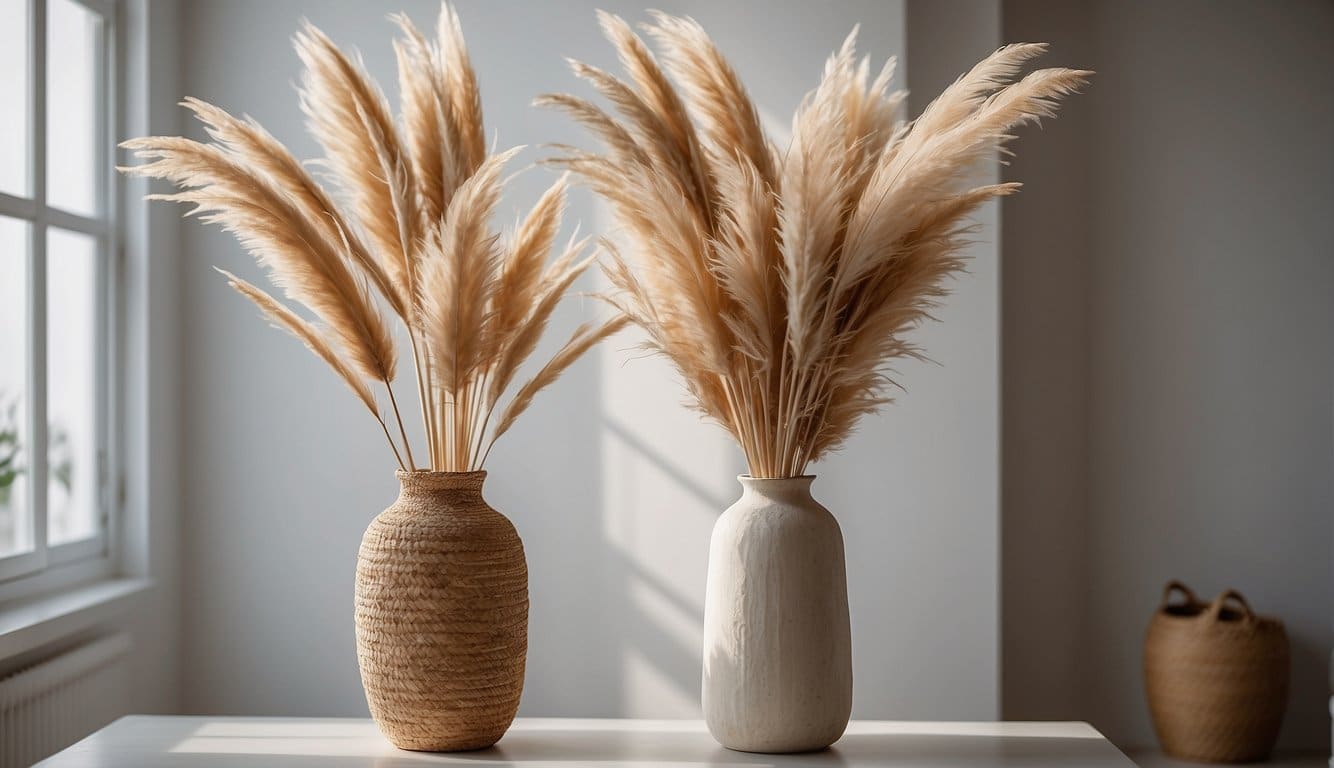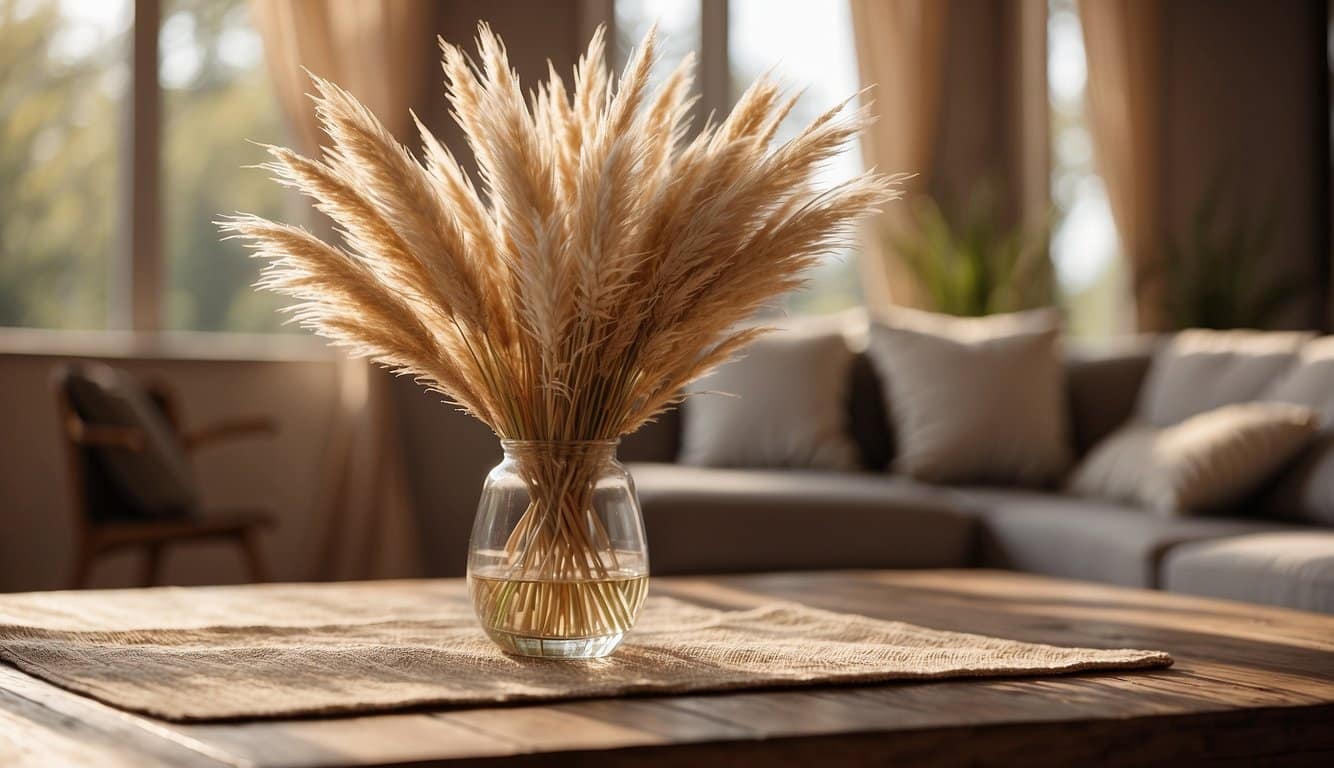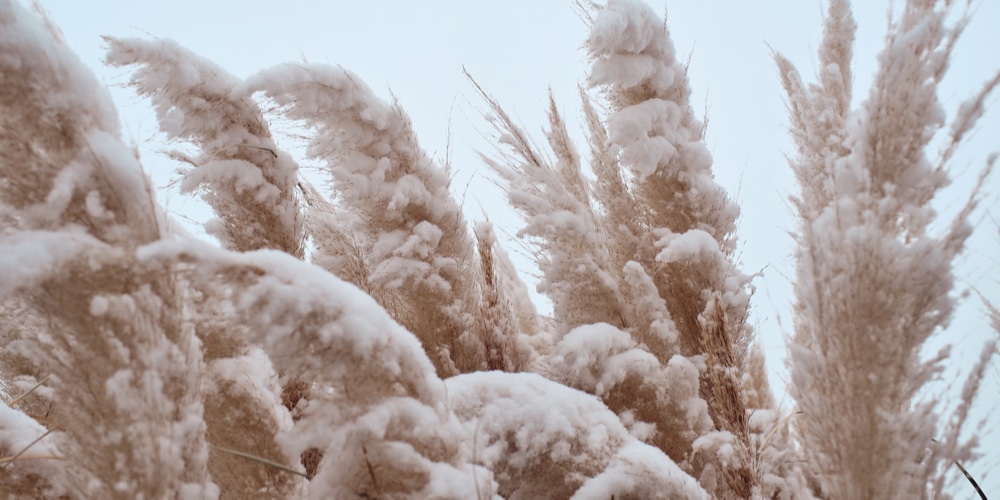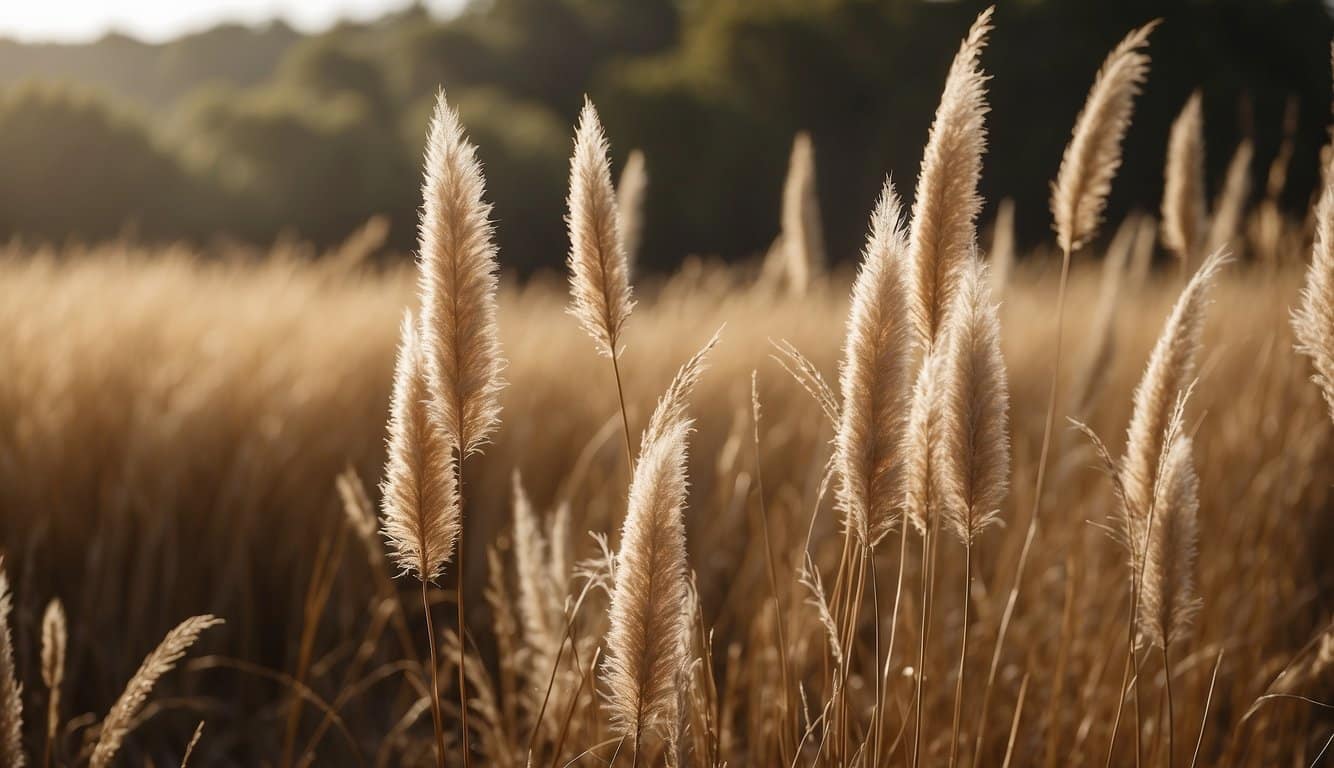
Dried pampas grass is a distinctive decorative element, appreciated for its feathery plumes and longevity. Originally from the grasslands of South America, Cortaderia selloana has found its way into homes due to its aesthetic appeal and ease of care.
Characteristics:
- Texture: The plumes are fluffy and soft.
- Color: Ranges from sandy beige to silvery white.
- Height: Can vary significantly, often several feet tall.
Preservation Process:
- The grass is harvested, often in late summer, and then hung upside down in a cool, dry place away from direct sunlight to prevent decay and fading.
- The drying process is critical and, when done correctly, prolongs the display life of the grass.
Lifespan and Care:
- Lifespan: When dried and kept under optimal conditions, the grass can last up to three years.
- Storage: Preferably stored in a cool, dark, and dry place.
- Handling: Minimize handling to reduce shedding.
Due to its neutral colors and varied textures, designers and homeowners often use dried pampas grass in creating a cozy, yet sophisticated ambiance in interior spaces. It is also popular in floral arrangements, particularly in weddings, for its elegant and rustic charm. With proper care, dried pampas grass continues to be a sustainable and stylish choice for those looking to add a touch of natural elegance to their decor.
Cultivation and Harvesting
In this section, the focus is on the specific conditions required for the growth of pampas grass and the steps involved in harvesting the plant for its desirable plumes.
Growing Conditions
Pampas grass thrives in well-drained soil under full sun exposure, necessitating at least 6-8 hours of daylight. Optimal growth occurs within a temperature range that doesn’t dip below 65 degrees Fahrenheit. This plant requires ample space to expand, as mature clumps can reach widths of up to 8 feet.
When planting, the following should be noted:
- Soil Preparation: Loamy, well-draining soil.
- Spacing: At least 6 feet apart for a hedge; 8-10 feet for individual plants.
Harvesting Process
The best time to harvest pampas grass is late summer through early fall when its plumes are fully developed but before they begin shedding. One should cut the stalks as close to the base as possible.
To ensure longevity of the plumes:
- Harvest on a dry day.
- Allow to dry in an area with ample airflow.
- Store dried plumes in a cool, dark place to prevent degradation.
Decorative Uses
Dried pampas grass has surged in popularity as a versatile decoration choice, adept at enhancing both interior spaces and special events with its textured, feathery plumes.
Interior Decoration
Pampas grass elevates the aesthetic of home interiors through its natural, soft appearance. Designers often place singular stalks in minimalist vases to create a striking focal point against plain backdrops. Alternatively, bundles of these wheat-toned plumes can fill larger containers for a more dramatic effect. They blend well with various design themes, from rustic to contemporary settings.
- Living Rooms: Grouped in a corner or as a mantelpiece.
- Bedrooms: A small vase on a nightstand.
- Offices: A subtle touch on a bookshelf.
Event Styling
For events, dried pampas grass offers a dreamy and rustic charm. It’s commonly used in weddings, where it can line aisles, accentuate archways, or serve as table centerpieces. Due to its neutral color palette and volume, it harmonizes with different color schemes without overwhelming the senses.
- Weddings: Aisle decorations, bouquet accents, and featured in ceremonial arches.
- Corporate Events: Stage backdrops and reception area arrangements.
- Parties: Enhancing entranceways or as part of thematic decor pieces.
Care and Maintenance
Maintaining dried pampas grass is essential for preserving their beauty and longevity. Proper cleaning techniques and knowledge of how to keep them lasting longer can significantly enhance their lifespan and appearance.
Cleaning Techniques
To clean dried pampas grass, one should gently shake the plumes to dislodge any dust. It is recommended to perform this task outdoors to avoid the spread of dust indoors. For a deeper clean, a hairdryer set on the cool and low setting can be used to blow dust off the delicate fibers. Always hold the hairdryer about a foot away from the plumes to prevent damage.
Longevity Tips
To ensure dried pampas grass stands the test of time:
- Avoid Moisture: Keep them in a dry area as moisture can lead to mold.
- Sunlight: Place away from direct sunlight to prevent fading.
- Storage: If they must be stored, wrap the plumes in paper to protect them and keep the shape intact.
- Dusting: Periodically dust the plumes using the hairdryer technique mentioned earlier.
Environmental Impact
Dried pampas grass, while often sought after for its aesthetic appeal in floral arrangements and home decor, also has a significant environmental impact. Cortaderia selloana, commonly known as pampas grass, originates from South America but has been introduced to various parts of the world as an ornamental plant.
Invasive Species: When pampas grass finds its way into non-native environments, it competes aggressively with indigenous flora. It turns into an invasive species due to its high adaptability and rapid growth rate, crowding out local plants and disrupting native ecosystems.
- Habitat Alteration: Large clumps of pampas grass alter habitats by changing the soil composition and blocking sunlight for smaller plants, leading to reduced biodiversity.
- Fire Risk: Pampas grass is highly flammable. Its dry foliage can contribute to fire hazards, especially in areas prone to wildfires.
Water Utilization:
- This robust grass requires a significant amount of water to thrive, which can strain local water resources. In areas where water is scarce, its presence can further deplete valuable water supplies.
Biodegradable Decorative Use:
- On a positive note, because dried pampas grass is a natural, biodegradable material, its use in decor minimizes the environmental footprint compared to synthetic alternatives. However, this benefit is often overshadowed by the ecological concerns associated with its growth and propagation.
Management Efforts:
- Mechanical Removal
- Chemical Control
- Public Education
Frequently Asked Questions
In the quest to maintain the beauty of dried pampas grass, enthusiasts often have various inquiries. This section aims to concisely answer some of the most common questions regarding the care, use, and legal considerations of this decorative plant.
How do I care for dried pampas grass to ensure its longevity?
To prolong the life of dried pampas grass, one should keep it in a dry environment and handle it gently to avoid crushing the delicate fronds. Regular dusting and avoiding exposure to moisture will help maintain its appearance.
What are the best methods to prevent dried pampas grass from shedding?
Preventing shedding can be achieved by using a hairspray or a plant sealant spray. Lightly coating the plumes after drying helps to bind the fibers and minimize shedding, ensuring the pampas grass retains its texture and form.
Are there legal restrictions on harvesting pampas grass in certain regions?
Yes, there may be restrictions on harvesting pampas grass in some areas due to its invasive nature. It’s essential to consult local guidelines and obtain necessary permits when foraging or removing the plant from public lands.
What creative ways can dried pampas grass be incorporated into home decor?
Dried pampas grass can be used creatively in vases, wreaths, or as part of a larger floral arrangement. It complements warm, neutral color schemes and can add a bohemian or rustic touch to interior spaces.
Where can one find high-quality dried pampas grass for bulk purchase?
High-quality dried pampas grass is often available from specialty florists, craft stores, or through online retailers that specialize in dried plants and home decor materials. Bulk purchases should consider factors like stem length, plume fullness, and color consistency.
Can dried pampas grass be used for outdoor decorations, and if so, how can it be weatherproofed?
While dried pampas grass is generally used indoors, it can be incorporated into protected outdoor spaces.
To weatherproof, one can spray with a waterproofing sealant designed for dried plants, and place them where they’ll be sheltered from direct rain and strong winds.
Last update on 2025-06-06 / Affiliate links / Images from Amazon Product Advertising API



